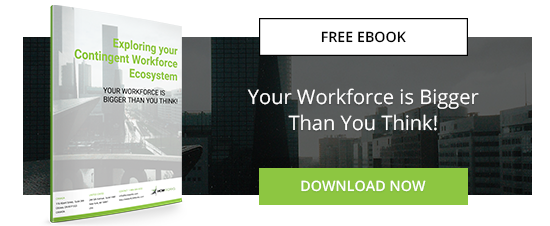The contingent workforce provides your organization with many significant benefits. But managing contingent workers also comes with some challenges.
The key challenge many organizations face is finding the appropriate balance between limiting risk, while on the other hand, being able to proactively respond to ever demanding business needs.
Here are the 3 main challenges organizations are facing:
Choosing your contingent workforce technology
Tracking and administering your contingent workforce into a single integrated technology system is a critical part of any contingent workforce strategy. The technology that’s right for you will depend on your organization’s global technology strategy, your service delivery model, and your comfort level with outsourcing, and possibly many other drivers.
There are many technology options for tracking and managing contingent workers, ranging from traditional ERP-based human resource management systems (HRMS) to numerous vendor management systems (VMS). And there are a number of practical considerations you need to consider, much depending on the total number of contingent workers you have, how distributed the workforce administration is, the tolerance for leveraging provider technologies, and what level of analytics and decision support capability your organization needs to provide to managers.
Consolidating your vendors
Each sourcing provider you use for your contingent workforce brings different strengths and capabilities.
You’re probably faced with the challenge of deciding what is the appropriate mix of outside sourcing vendors for your company, and how to balance vendor strength with the need to manage labor costs and a wide geographic footprint.
Every organization needs to develop a vendor strategy that can scale at a cost that provides ongoing value to the business. It helps to use a “short list” of vendors that are carefully aligned, vetted and approved to source contingent workers and they should be made accountable for supporting the organization’s risk and cost management practices.
Where should ownership and accountability lie?
Which function in your organization should own the overall process and be specifically responsible for all the parts of the contingent workforce lifecycle?
We have seen some effective contingent workforce management models by either Procurement or HR, or in many cases, a blended team comprised of both.
Which ever way you organize yourselves, successful contingent workforce management can only be accomplished when there is careful integration across the entire organization with joint ownership and accountability. That means that with finance - for costing and budgeting, procurement - for vendor strategy, contracting, pricing and supplier evaluation components, with legal - to provide risk analysis and specific direction regarding processes and practices, and HR, who are ultimately going to be responsible to integrate contingent workers into existing processes, policies, and guidelines of the organization.
About HCMWorks
We are a contingent workforce service provider helping organizations gain better access to talent through the use of independent contractors, consultants, temporary workers, freelancers and other non-payrolled employees. We provide the expertise, the technology, and processes to help you reduce your workforce costs, mitigate against misclassification and co-employment risks, and increase the efficiency and timeliness of your contingent recruitment process. Read more about what our clients say about us here.



